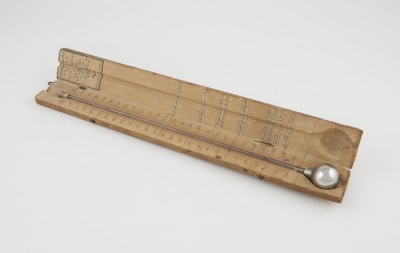The degree Celsius is a unit of temperature on the Celsius scale, a temperature scale originally known as the centigrade scale. The degree Celsius (symbol: C) can refer to a specific temperature on the Celsius scale or a unit to indicate a difference or range between two temperatures. It is named after the Swedish astronomer Anders Celsius (17011744), who developed a similar temperature scale in 1742. Before being renamed to honour Anders Celsius in 1948, the unit was called centigrade, from the Latin centum, which means 100, and gradus, which means steps. Most major countries use this scale; the other major scale, Fahrenheit, is still used in the United States, some island territories, and Liberia. The Kelvin scale is of use in the sciences, with 0 K (-273.15 C) representing absolute zero.
Since 1743 the Celsius scale has been based on 0 C for the freezing point of water and 100 C for the boiling point of water at 1 atm pressure. Prior to 1743 the values were reversed (i.e. the boiling point was 0 degrees and the freezing point was 100 degrees). The 1743 scale reversal was proposed by Jean-Pierre Christin.
By international agreement, between 1954 and 2019 the unit degree Celsius and the Celsius scale were defined by absolute zero and the triple point of water. After 2007, it was clarified that this definition referred to Vienna Standard Mean Ocean Water (VSMOW), a precisely defined water standard. This definition also precisely related the Celsius scale to the Kelvin scale, which defines the SI base unit of thermodynamic temperature with symbol K. Absolute zero, the lowest temperature possible, is defined as being exactly 0 K and 273.15 C. Until 19 May 2019, the temperature of the triple point of water was defined as exactly 273.16 K (0.01 C). This means that a temperature difference of one degree Celsius and that of one kelvin are exactly the same.On 20 May 2019, the kelvin was redefined so that its value is now determined by the definition of the Boltzmann constant rather than being defined by the triple point of VSMOW. This means that the triple point is now a measured value, not a defined value. The newly-defined exact value of the Boltzmann constant was selected so that the measured value of the VSMOW triple point is exactly the same as the older defined value to within the limits of accuracy of contemporary metrology. The degree Celsius remains exactly equal to the kelvin, and 0 K remains exactly 273.15 C.
Jean-Pierre Christin (31 May 1683 – 19 January 1755) was a French physicist, mathematician, astronomer and musician. His proposal in 1743 to reverse the Celsius thermometer scale (from water boiling at 0 degrees and ice melting at 100 degrees, to where zero represented the freezing point of water and 100 represented the boiling point of water) was widely accepted and is still in use today.Christin was born in Lyon. He was a founding member of the Académie des sciences, belles-lettres et arts de Lyon and served as its Permanent Secretary from 1713 until 1755. His thermometer was known in France before the Revolution as the thermometer of Lyon. One of these thermometers was kept at the Science Museum in London.

1743May, 19
Jean-Pierre Christin developed the centigrade temperature scale.
Choose Another Date
Events on 1743
- 12May
Charles VII, Holy Roman Emperor
Maria Theresa of Austria is crowned Queen of Bohemia after defeating her rival, Charles VII, Holy Roman Emperor. - 19May
Centigrade temperature scale
Jean-Pierre Christin developed the centigrade temperature scale. - 13Sep
Treaty of Worms (1743)
Great Britain, Austria and the Kingdom of Sardinia sign the Treaty of Worms.

 English
English  español
español  français
français  português
português  русский
русский  العربية
العربية  简体中文
简体中文 